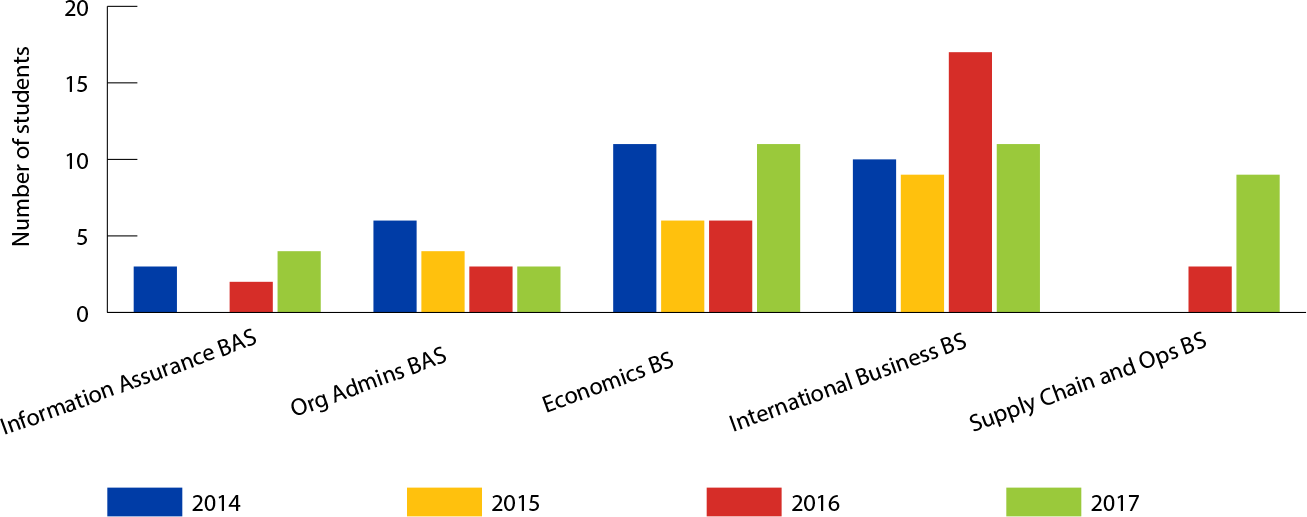Graduation rates are measured as the number of graduates each year, by major. The charts below show graduates of the College of Business and Management programs.
Undergrad: The very large programs (Accounting and Business Administration) are relatively stable. Within the large programs, the BS in HRM and the BS in MIS have the highest overall growth. The others in this category show less overall and also less consistency in growth. In the small programs, the BAS degrees remain small but stable, the BS in Supply Chain and Operations began having graduates in 2015, and we expect continuous growth in that area. The remaining two in this group (BS in Econ and BS in Intl Business) have no obvious trends.
Graduate: In the graduate programs, the DBA program is consistently graduating students, the MIS program fluctuates yearly, and the MBA program is showing significant declining graduates.
Business Administration is the most popular degree - many of the students already have jobs, but need a BS degree to further their career, and the Bus Admin degree is general enough in nature to fit the needs for those students. Accounting, HRM, MIS, and Marketing are all career areas hat show growth, influencing growth in the programs. Supply Chain and Ops is also a fast-growing career area, and we expect continuous growth in that area. Within the graduate areas, the doctoral area shows a steady level of graduates, reflecting COM's continued success in students completing their dissertations. The MIS area is volatile, with fast changing needs to stay current with technological changes. We believe the decrease in MBA graduates reflects the increased local and online competition.
The improvements made over the last four years include the following: We continue to increase the number of community college campuses on which we locate our BAS in Org Admin and our BS is Bus Admin courses to increase enrollment in those areas. We have added four more concentrations to the MMIS program (which used to be certificates) to help them see a path to graduation. Another internal change was to enhance the capability of the degree audit tool to make it easier for students to see exactly what requirements remain in order to graduate. We have made connections with various Supply Chain organizations to encourage students to complete our Supply Chain and Ops program. We have increased our visibility in the region by holding more informational career fairs and career service opportunities, as well as encouraging the creation of a CBM business club that helps students explore and be better prepared and more motivated to complete their degrees.
Very large programs, 2014–17

| 2014 | 2015 | 2016 | 2017 | |
|---|---|---|---|---|
| Accounting BS | 143 | 165 | 137 | 135 |
| Business Administration BS | 258 | 249 | 275 | 262 |
Large programs, 2014–17

| 2014 | 2015 | 2016 | 2017 | |
|---|---|---|---|---|
| Finance BS | 32 | 48 | 40 | 45 |
| HRM BS | 38 | 39 | 50 | 68 |
| Management BS | 51 | 48 | 39 | 44 |
| MIS BS | 34 | 23 | 32 | 55 |
| Marketing BS | 55 | 61 | 52 | 52 |
Smaller programs, 2014–17

| 2014 | 2015 | 2016 | 2017 | |
|---|---|---|---|---|
| Information Assurance BAS | 3 | 0 | 2 | 4 |
| Org Admins BAS | 6 | 4 | 3 | 3 |
| Economics BS | 11 | 6 | 6 | 11 |
| International Business BS | 10 | 9 | 17 | 11 |
| Supply Chain and Ops BS | 0 | 0 | 3 | 9 |
Graduate programs, 2014–17

| 2014 | 2015 | 2016 | 2017 | |
|---|---|---|---|---|
| MBA | 64 | 56 | 56 | 33 |
| MMIS | 21 | 16 | 25 | 17 |
| DBA | 5 | 5 | 5 | 4 |
